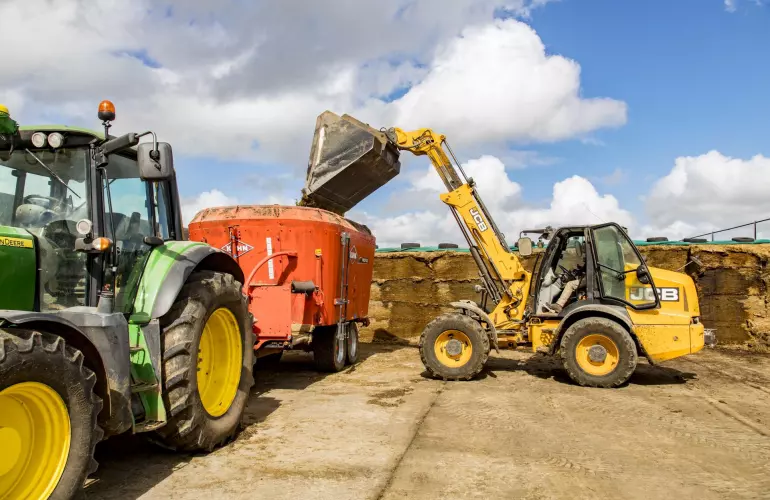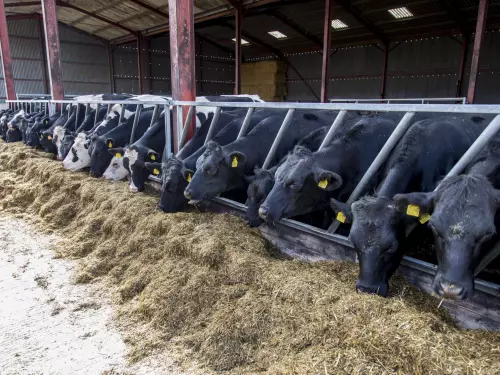Accuracy in all aspects of feeding is seen by Gloucestershire dairy farmer Scott Kingston as a key building block for the business.
It’s one of his main areas of responsibility at 240-cow Tresham Farm, Woton-under-Edge - where he works alongside his brother Matt and father Nigel - and has been integral to the herd’s progress in recent years.
In addition to self-education, including a course on dry cow nutrition to extend his knowledge, Scott has drawn on the expertise of consultants such as James Husband. The farm has also invested in a diet feeder with the capability to reliably weigh, mix, feed and record a varied array of rations with the required level of precision.The Holstein-Friesian herd currently has a lactation average of around 10,000 litres/cow, with constituents of 4.15% butterfat and 3.15% protein. Other key performance indicators are equally impressive, with exceptional herd fertility reflected in a calving interval of 365 days and a cell count of 111 pointing to very good udder health. Metabolic diseases are also now at a relatively low level, but this had previously been an area of concern and was one of the reasons why Scott now prioritises herd nutrition.
“Around five years ago we were seeing a lot of milk fever and high numbers of RFMs (retained foetal membranes),” recalls Scott. “The problem was in the feeding and has been solved by introducing a DCAD transition ration for four weeks prior to calving. ''
“The transition ration typically includes straw and hay – lower in potassium than grass silage – as well as some maize silage and the all-important anionic salts that acidify the rumen. Since introducing the transition ration, we’ve seen a dramatic reduction in these metabolic diseases in the herd, and this has without doubt had a positive knock-on effect for many other areas of herd productivity.”
Introducing a transition diet has been a big positive for the Tresham Farm herd, but it has added an extra level of complexity to a feeding routine that on any one day will include as many as four different rations spread across 650 cattle. It’s a workload that requires a feeder that is first and foremost robust and reliable and also has the technology to deliver rations with efficiency and accuracy.

“Our previous feeder was wearing out, in critical places like the hopper sides and the auger, so we were looking for a replacement machine that would have real durability,” says Scott. “Ideally, we wanted a machine that would last at least 10 years, and one that would do all that we wanted in terms of mixing and distribution.
“After researching the market thoroughly and reviewing all the options, we settled on the Kuhn Profile, a twin vertical auger machine with 24 cubic metre capacity, front conveyor and programmable weighing. One of the key selling points for us was the fact that the hopper and auger construction is of the same engineering and quality as the company’s static mixers, which are designed for far longer hours of use than we’d ever imagine our machine doing.”
In March 2017, when Tresham Farm took delivery of the Profile 24.2 CL, it was the first machine to feature Kuhn’s long-life K-NOX augers, with the entire auger unit of coil, cone and scraper protected to provided added resistance to the wear and tear caused by friction, acidic feed, and general corrosion.
“The mixing capability is important for all rations, but particularly for the transition diet where we’re including a significant amount of straw,” adds Scott. “We don’t use a separate straw-grinder but instead use the Profile to chop and mix the straw into the transition diet. It means this ration takes about twice as long to prepare than the milking cow rations, but by achieving the right level of chopping and mixing we’re avoiding the risk of the cows sorting the feed, and that means all animals are receiving the right diet and potential problems are avoided.”
Scott applies this level of care and attention to all rations and – with replacement heifers, early lactation high yielders, and lower yielders at grass receiving a buffer feed – that can mean another three mixes each day, on top of the transition ration. Keeping track of the different rations is made easier by the DigiStar programmable weighing system on the Profile, with information being transferred from his laptop in the farm office to the feeder through a memory stick.
“Having this ability to record and store information is important for maintaining accuracy, especially on days when I’m not around and someone else is responsible for the feeding,” he adds.
Adopting a standard approach to mixing and loading is another trick that helps to maintain ration consistency. Firstly, a standard pre-mix is prepared approximately weekly in the Profile, with soya, wheat, concentrate feed and minerals mixed in the correct proportions and then stored for daily use. A rear hatch on the Profile makes a convenient despatch point for this purpose. With the daily ration mixing, the pre-mix always goes in first, to ensure the highest level of accuracy, and then any straw, with this followed by grass silage, maize and wholecrop.
“Our grass silage is longer chopped, as we use a forage wagon for harvesting, so this goes into the Profile before the maize and wholecrop, to allow longer to chop and mix,” explains Scott. “As with the straw in the transition diet, we’re looking for an optimum mix that results in a consistent diet for all cows and avoids any sorting.”
With all replacements bred on the farm, the 650 cattle are spread across a number of locations on the farm, with varying access. It’s therefore an advantage having the Profile with a front cross conveyor, allowing feed-out to either side, and with a hydraulic elevator for added height when required.
With such a clear focus on correct nutrition, Scott is convinced that the family has the basis to succeed in the key areas of herd health and fertility. He is, however, quick to acknowledge that this only delivers if other parts of the management are carried out equally well.
“My brother Matt ensures all cows’ feet are trimmed before drying off and at 60-day post-calving,” he says. “This, along with routine foot bathing, is the main reason we have little trouble with lameness, and that’s another key area which we need to stay on top of.
“Matt, along with our stockman Liam, also takes care of the DIYAI, which is a key part of maintaining the calving interval.
“Ultimately, all these factors have to work together and on a family dairy farm that has to be a team effort.”
Looking forward, the aim for the Kingston family is to maintain the current high levels of herd health and fertility in order to consolidate the currently strong position. Investment in a new 32-point rapid exit parlour has been important to modernise the facilities and is another indication of a positive future ahead.

Accuracy in all aspects of feeding is seen by Gloucestershire dairy farmer Scott Kingston as a key building block for the business.

The farm has also invested in a diet feeder with the capability to reliably weigh, mix, feed and record a varied array of rations with the required level of precision.
